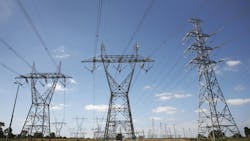Infrastructure Investment: The Key to Energy Dominance & Economic Prosperity
History may not always repeat itself, but it often rhymes. And throughout America's history, infrastructure investment has driven many of the nation’s significant economic leaps forward.
Whether it was James Monroe's advocacy for new roads, canals, and bridges; Abraham Lincoln’s leadership enabling transcontinental railways; or the federal highway system championed by Dwight D. Eisenhower, public-private infrastructure partnerships have reliably served as an economic catalyst.
The nation’s infrastructure is once again at a critical juncture. Strategic competition with China on artificial intelligence is straining the U.S. power grid, as new data centers are struggling to come online due to challenges in connecting to new power generation. Persistent inflation and gaps in wealth and income have left many Americans struggling to pay their bills. And recent extreme weather events have left millions without power — and disrupted operations at military bases.
A common thread among these seemingly disparate challenges is a lack of adequate transmission lines connecting America’s balkanized power grids. That lack of infrastructure is contributing to generally rising energy costs, preventing consumer savings on electricity, specifically.
The incoming Trump administration has fortunately recognized this issue, promising to halve energy prices in 18 months. While undoubtedly an ambitious goal – and out of reach for globally priced energy sources – there are several pragmatic actions the incoming Administration can take to position the nation for domestic energy dominance by continuing the American tradition of public-private collaboration to enable needed infrastructure.
First, streamline federal permitting rules. Achieving energy dominance requires maximizing the availability of low-cost, domestic energy production. As it relates to electricity generation, that means reliable access to the most affordable sources of power. Streamlining federal permitting for transmission lines would help private sector developers speed up the completion of new lines – including those connecting neighboring grid regions – which will ensure lower-cost, reliable power in future severe weather events. As recent experience with Winter Storms Uri and Elliott demonstrated, power grids bigger than weather systems are needed, as all generation sources are prone to production declines under extreme conditions.
Second, maximize the use of existing rights-of-way to enable new American manufacturing and data centers. The U.S. Department of Energy’s Grid Deployment Office recently succeeded in accelerating investment in grid enhancing technologies (GETs) and high-performance conductors (HPCs), which rapidly and cost-effectively add capacity to the existing grid footprint. For example, federal grants will enable Georgia Power Company to deploy GETs on its system, helping add critical capacity and flexibility to meet load growth. In another grant, eight Southeastern states across the Tennessee Valley Authority received funding for 84 resilience subprojects, including HPC installation, estimated to spur the creation of 800 jobs and deliver $250 million in economic impact. There are many other regions that would benefit from similar investment.
Third, take regulatory action to enable more efficient transfers of power between grid regions in the Eastern half of the U.S. Requiring optimization of existing interties, the points at which the regional power markets connect, would save businesses millions annually on their power bills. Regional market monitors in New England, New York, and the Mid-Atlantic have recommended such reforms for about two decades. Optimizing interties and available transmission in the West collectively saved consumers more than $4 billion from 2014 to 2023, while similar optimization in the East could provide approximately $50-60 million annually in additional value.
Finally, lean into the bipartisan goals to increase energy security and domestic manufacturing. The President and Congress have an opportunity to work together to encourage and incentivize the development of more American-made electric transformers and the components for high-voltage lines that are needed to efficiently deliver power long distances. This issue is particularly salient as America’s economic competitors in China and the European Union continue to buy up the global supply of key technologies to modernize grid infrastructure. China has already developed 34 ultra-high voltage lines, while the U.S. has none. European states have made similar investments, with approximately 130 gigawatts of new high-voltage direct current lines planned or under development through the end of the decade. With global supply shortages already apparent due to those procurements, encouraging domestic manufacturing of key components is necessary.
History also serves as a guide on what happens when nations neglect to make investments in infrastructure advancements at critical junctures. For example, in the early 1800s, the Hapsburg Empire feared the potential creative destruction of market forces enabled by the Industrial Revolution. Francis I, the first Emperor of Austria, wanted to lock in the status quo to protect existing elites and thus blocked the construction of railways.
Since the government would not grant a concession to build a steam railway, the first built in the empire had to use horse-drawn carriages. Design choices necessary to accommodate the carriages subsequently made it impossible to convert the route to enable steam engines – delaying decades of economic progress before steam engines were implemented in the 1860s, after a revolution. In short, efforts to protect outdated interests from new technologies cemented dated infrastructure as other nations raced ahead. It was one of many costly mistakes the Hapsburgs never recovered from.
While the U.S. is, of course, not a monarchy, similar perverse incentives exist here today. Recent studies demonstrate that significant new interregional transmission is needed to grow the American economy and ensure reliable power service—yet it’s not getting built.
Our new national leaders have the chance to change that dynamic and build an economic success story. There are 1.3 million jobs possible from enabling the completion of just 36 high-capacity transmission projects that are “shovel ready” today.
Let’s build on the infrastructure lessons learned from Monroe, Lincoln, and Eisenhower and have this page in America’s history books similarly prosperous. Stronger grid infrastructure powered by our most affordable, reliable, and clean technologies will benefit us all.
About the Author
Kevin O’Rourke
Kevin O’Rourke is SVP, development and public affairs, at ACORE.
